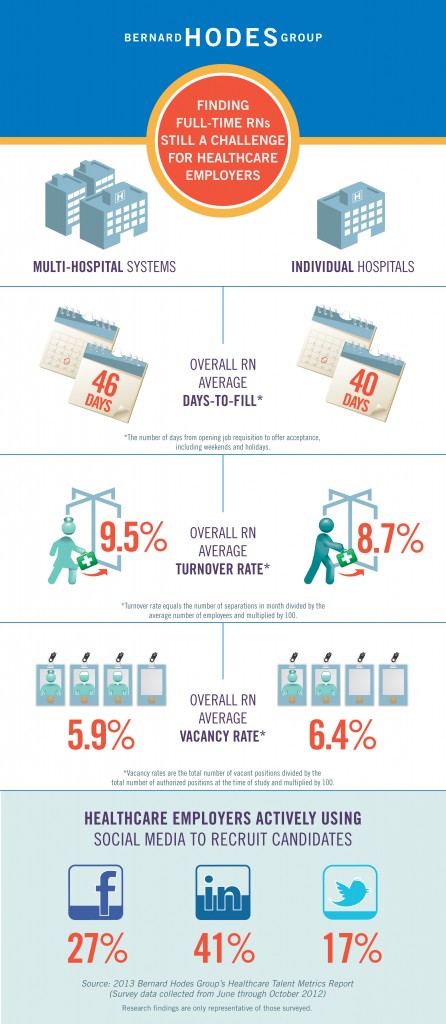 During a recent meeting with a client who was struggling to find candidates, I was asked what they could do differently. The same tried-and-true methods were no longer yielding results, and their tactics were sporadically successful at best.
During a recent meeting with a client who was struggling to find candidates, I was asked what they could do differently. The same tried-and-true methods were no longer yielding results, and their tactics were sporadically successful at best.
This client was hardly alone.
To perform at the highest levels of standards and quality, a hospital must be properly staffed to meet the needs of its patients.
For more than a decade, healthcare has experienced a shortage of workers, most notably experienced registered nurses. As the recent Bernard Hodes Group Healthcare Talent Metrics survey indicates, healthcare organizations can increase their chances of hiring more qualified employees by implementing employer brand-driven strategies and tactics that reach and engage the candidate audience more consistently.
Qualified Candidates: Where Did They Come From?
As my conversation with the aforementioned client continued, I asked where their talent came from. They could recite the myriad sources they used, but struggled to confirm whether or not those sources were yielding results.
Hodes’ Healthcare Talent Metrics revealed that 63 percent of those employers surveyed primarily rely on candidates’ self-reported data, which has proven to be unreliable, to track their external source of hire. A better practice is to consider the far-more accurate tags used in online ad tracking.
The transformation from print to online advertising was a marvel to save on advertising costs. But the true beauty of advertising jobs online is the ability to tag your ads and track all the way through to hire — something a minority of healthcare organizations are currently doing.
Also, referrals are ranked as one of the top five highest yielding sources of RN hires by 78 percent of the respondents. CareerXroads’ Source of Hire 2013: Perception is Reality research shows that in 2012 referrals were the leading external source of hire at 24.5 percent.
Let Social Media Do The Talking
Just as social media is a fast-growing communication norm for family and friends, it’s now a recruiting tool gaining steam to find and attract candidates. But social shouldn’t be used just to advertise job openings. This is an opportunity for healthcare organizations to converse with candidates, engaging them by demonstrating the employer brand experience, even before a potential candidate considers submitting an application.
AMN Healthcare’s 2011 Social Media Survey revealed that, “Nearly one-third (31 percent) of respondents cited that they are using social media for job searching.” This is a significant increase from the year before which measured only 21 percent using social networks to search for jobs.
These numbers are bound to increase with candidates becoming more comfortable with using social media, and the increased youth in the workforce, who grew up using social media personally and during their studies.
Numbers and facts should be enough to encourage healthcare employers to consider utilizing social channels; however, the Hodes Healthcare Talent Metrics report found that of those surveyed, only 29 percent indicate they have a “career-focused” company page on Facebook, and only about 34 percent have a “career-focused” page or group on LinkedIn, with 17 percent having a paid/enhanced LinkedIn careers tab.
Clearly, there is a disconnect between the numbers of those using social media for recruitment and the increasing number of candidates using social media to search for jobs. Healthcare employers may be leaving a communication gap between themselves and candidates, and neglecting an opportunity to find new talent.
If It Takes Longer To Fill a Position, Don’t Lose Candidates’ Interest
It may not be surprising to know that larger healthcare providers and systems take longer to fill RN and Allied Health positions. For example, those healthcare systems that participated in the Hodes survey responded that, on average, it takes 54 days to fill occupational therapist positions, compared to individual hospitals and other providers that take about 36 days to fill those same positions.
The reasons for a lengthy hiring process may vary due to factors such as heavier recruiter workloads and having a complex hiring process.
Don’t risk losing candidates’ interest in jobs because the process takes longer. Developing strategies to keep candidates engaged throughout the process, such as frequent and personalized communications articulating the employer brand, can show candidates your desire for them to join the organization.
Conclusion
The U.S. healthcare system is at a critical juncture with the implementation of healthcare reform. The stakes are increasingly high for healthcare organizations that need to balance a high level of care with the new reform requirements. With reimbursement on the line, healthcare organizations must become more proactive and recognize where they may be missing opportunities to find and hire qualified talent.